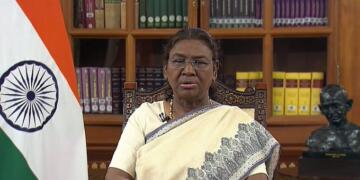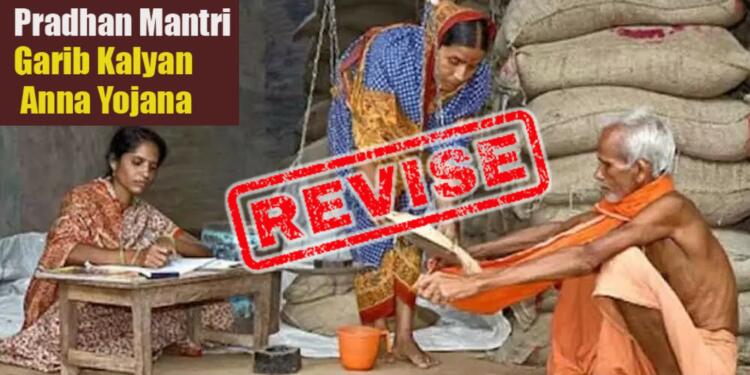Pradhan Mantri Garib Kalyan Yojna (PMGKAY) is possibly the most famous flagship social sector scheme of the Modi government. It has been so successful that even the IMF has sung praises about it. But it seems as if the Modi government got carried away with it. Otherwise, they would have done some changes to the allocation formula under the scheme.
Modi Government to Continue PMGKAY
Recently, the Modi government decided to extend the PMGKY for 3 more months. Now, the facility of free food grains under the scheme will be available till the end of December this year. The decision was taken in a Cabinet meeting chaired by Prime Minister Narendra Modi himself.
According to the Press Information Bureau, the extension of the scheme will cost Rs 44,762 crores to the state exchequer. Spending on 122 Lakh Metric Tonnes will take the overall cost of the scheme from Rs 3.45 lakh crore to Rs 3.91 lakh crore for the Centre.
Also read: IMF’s report on India’s food security is a tight slap to detractors of Modi government
Finance Ministry Opposed It
Meanwhile, the decision did not come with consensus. Reportedly, the Finance Ministry had said no to the proposal of extending the scheme. Nirmala Sitharaman led Ministry is apprehensive about it turning into another one of those freebie schemes.
An office memorandum from the Finance Ministry’s Department of Expenditure read, “Continuation of this over a long period of time may give an impression of its permanent or indefinite continuation and make it difficult to stop. Hence terminating the scheme on September 30, 2022 is advisable. As such the proposal is not supported.”
The Finance Ministry’s disagreement with the order clearly indicates that it is not an economically wise decision. The Ministry has access to the best sources of data and its recommendations did not come out of thin air. If you look at the interplay of GDP growth rate, impact of PMGKAY on economy, job growth, crop estimation for the year and people’s income, the picture will get clearer. First let’s have a brief look at PMGKAY.
PMGKAY Has Been Successful
The scheme was the need of the hour during the pandemic. In March 2020, the Modi government announced that it will be providing extra rations to more than 80 crore Indians. The food security scheme was named Pradhan Mantri Garib Kalyan Anna Yojana (PMGKAY). The PMGKAY scheme ensured that every needy person in the country would avail 5 kg of food grains per month. This extra ration was available to those who were already registered beneficiaries under National Food Security Act (NFSA).
Initially, the scheme was considered a waste since 67 per cent of the population was already covered under the National Food Security act. An extra scheme was considered futile. But, later experts revealed that PMGKAY was the main reason behind millions of Indians not sliding down to the level below extreme poverty.
Government Continued it Beyond Reasonable Time
PMGKAY performed brilliantly at first and helped India revive its economy by ensuring that people’s savings remained intact. However, after 18 months, demand for doing away with the scheme started to gain momentum. The reason was that India’s economic growth had started to clock double digits. But the government was apprehensive about discontinuing it.
It had its own reason as well. Factory output had just started to get momentum and people were just getting updated with their new routines. But negativity about covid was still in the air and the government wanted to ensure its population that it would be there for them in times of need. Additionally, global headwinds in the wake of the Ukraine-Russia crisis made the government more sceptical about discontinuing it. Needless to say, it was also not politically expedient. So, the government kept extending it.
Also read: Free ration during COVID created many freeloaders, that stops now
Problems for Government
But times have changed now. And times have changed because numbers have changed. When the scheme was introduced, FCI godowns were so full that leakage, wastage and pilferage were problems, but never the availability of grains. Times have changed now. In fact, it started to change way back in February and March.
At that time, India emerged as the saving grace of the world and exported wheat to the developed as well as underdeveloped nations. The increased demand for made-in-India wheat transformed into India exporting 70 million tons of wheat to the world. It was over and above feeding our people under PMGKAY and NFSA. But the happiness was short-lived.
Also read: India is ready and willing to feed an increasingly hungry world
Poor Crop Estimates
Poor Monsoons started to affect Indian crop production estimates. In that scenario, hoarding of Indian wheat by China meant that India had to halt wheat export. At home, the government cut the quota of wheat being allocated to beneficiaries as well. To revive the foodgrain stocks, the government put a lot of effort to revive seed sowing and cultivation as well, but could not bring much change to the godowns.
Government’s own estimates present a relatively grim picture of crop availability in the country. According to latest estimates, rice production in FY 2022-23 will fall down by 6 per cent from 111.76 MT to 104.99 MT. Not just rice, noticeable decline is being observed in cultivation of other crops as well. Total foodgrain capacity for this year will decline by 4 per cent. Numbers are grimmer in sub-sections of crops as well. Production of Kharif Coarse grain is slated to fall down by 28 per cent.
Also read: The real reason why India temporarily stopped exporting wheat
India’s Economy is Reviving
If these numbers are not good enough to convince the government, then record growth in GDP should be. Few weeks ago, India registered a record 13.5 per cent growth rate in GDP. Analysts say that India is the only major economy whose chances of getting stuck in recession is zero. We just pushed back our former colonisers to 6th position on the economic ladder.
Indian consumers have restarted consuming market products on mass scale. Yes, it is true that for now the upper and upper middle class are driving this growth. But it is only a matter of time before the phenomenon percolates down the economic ladder.
Demand is Rising
Proof of the pudding lies in the fact that MGNREGA, one of the biggest enablers of rural consumption, is witnessing an increase in its demand. Government said that compared to August 2022, the demand for MGNREGA jobs increased by 5 per cent in September 2022. The numbers are expected to increase since people are now looking to shift away from farm jobs, which they took up during Covid times due to lack of options.
These numbers only raise the questions over the veracity of reasons behind extension of PMGKAY. Apparently, increasing income should mean that people do not require free food anymore. But the question is whether it needs to be rationalised or should be done away with totally.
Need to Rationalise
To be honest, it needs more rationalisation than removal. Demands have picked up momentum, but not to their full capacity. It only indicates that there are millions of people who need more assistance in the form of incentives.
It would benefit if a concept such as creamy layer gets introduced in PMGKAY. Those who have benefitted from it should be removed from the beneficiary list while those who need it must be provided with free food. Even an increase in allotment would be good in case the beneficiary is below the poverty line.
Alternatively, a campaign where PM Modi himself comes up with an appeal to people about voluntarily leaving the scheme would also help. It helped in case of LPG subsidy. There is no reason to believe that it won’t work here.
Support TFI:
Support us to strengthen the ‘Right’ ideology of cultural nationalism by purchasing the best quality garments from TFI-STORE.COM





























